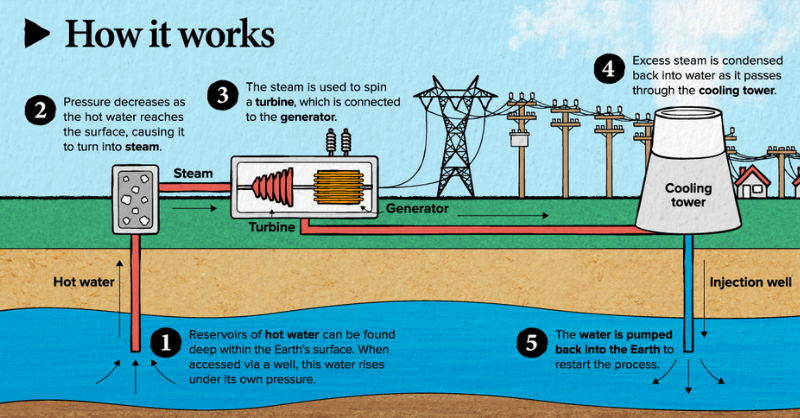
Geothermal electricity - power from the earth's heat
Geothermal electricity generation is currently (very) niche, only working in a few locations, and even then its expensive. But that is changing. New technologies offer the opportunity for it to be a financially viable balance to the variability of wind and solar.
Summary: Geothermal electricity generation is currently (very) niche, only working in a few locations, and even then its expensive. But that is changing. New technologies could make its use much more widespread, and they offer the opportunity for it to be a financially viable balance to the variability of wind and solar.
Why this is important: Renewables, especially solar, are likely to be the backbone of our future electricity generation system. But we need to be honest about their limitations. They are variable, meaning we will need other offsetting generation sources. Geothermal could be part of this, especially if the new Advanced Geothermal Systems can be economically scaled up.
The big theme: Electrify everything, together with a decarbonised electricity generation system, lie at the heart of most countries net zero plans. To make this a reality, we will need more wind and solar, plus a portfolio of alternative electricity generation sources, combined with more interconnectors, battery storage and demand management. The electricity grid of the future will look very different, we need to start preparing.
Generating electricity using the heat from the ground is appealing. Drill down into your heat source, add a steam turbine, and generate electricity. What could be more sustainable? So, given this, why does geothermal only account for 0.5% of global renewable energy capacity, a level than has barely changed in decades?
Geothermal currently works if you live somewhere like Iceland or Indonesia, but not elsewhere. And if that was not going to change, it would be hard to make the argument that this is a topic that sustainability finance people really need to understand. Especially when there are other, more scalable solutions, to investigate.
There are currently two material barriers to scaling up geothermal electricity generation. The first is location; there are only a few places in the world where geothermal electricity generation currently makes technological sense. And the second is cost, with Lazard estimating the capital cost as being higher than most other renewables, and considerably higher than using gas.
But this seems to be changing. Pilots are underway that could allow geothermal electricity to be switched on and off on demand, allowing it's use as a alternative generational source when solar and wind are not available. This can be a much higher value market segment than simple always on 'baseload'.
Beyond this, other new technologies are emerging that take advantage of fracking solutions, to enable geothermal to work in more locations. Research is also underway to investigate the re-use of abandoned oil & gas wells, which could reduce the upfront capital cost. Plus, outside of electricity generation, we are seeing an increase in demand for geothermal as a source for district heating and for agriculture.

The Detail
Summary of a report published by Rystad Energy
- Geothermal power generation initiatives are usually established in locations with very specific geological characteristics. On average, these projects hit reservoir temperatures of 210 degrees Celsius (°C), with many projects also having crossed the 300 degrees Celsius (°C) line. In such regions, operators typically drill deeper wells (on average 2 kilometer deep) to access the higher reservoir temperatures.
Why this is important
- In a future world with a lot more variable renewable electricity supply (wind and solar to you & I) we are going to need other electricity generation sources that are complementary. By that we mean that they either generate when the wind and sun are not available, or they can be easily ramped up as and when needed. These electricity sources will work alongside interconnectors and battery storage, plus demand management, to ensure we have a 24/7 electricity grid. This is where geothermal electricity could play an important role.
- If you want a good explainer on geothermal electricity generation, we like this one, from the Visual Capitalist. And remember as you read it, geothermal steam/heat is not only used for generating electricity. It can also be used in district heating, an expanding use case.

- Today we will look at future technologies for generating geothermal electricity. Lets start with the limitations of current geothermal applications. As well as being geographically limited and expensive to build, conventional geothermal has another drawback. It's always generating. This means that during the day it competes with cheaper solar, which can result in negative wholesale prices (see our recent blog below). This is not great for geothermal project economics.

- Yes, it's not a deal breaker. Geothermal can still fit into the portfolio of alternatives, but it doesn't have an obvious Unique Selling Point or USP -outside of the countries where the use case is clear (i.e. the Pacific Ring of Fire and other locations where plate tectonics create hot spots).
- But, there is an emerging technology that could change this dynamic. This is Advanced Geothermal Systems (AGS). And unlike traditional geothermal, they are closed loops. In what way is this different? Traditional geothermal energy access's reservoirs of hot water that are found below the earth’s surface. This pressurized water rises up and rapidly expands into steam. That steam is used to spin a turbine, which then drives an electric generator. This is an open loop. The hot water and steam must either be used, or released into the atmosphere.
- By contrast AGS is a closed loop system. A fluid is circulated down into zones of hot rocks, with the hot fluid coming back up to the surface, where it can be used to generate electricity or for district or industrial/agricultural applications. One way to think about it is as a giant heat transfer system. And while AGS happily operates as 'always generating' it can also be used to create dispatchable electricity. During periods of low electricity demand, such as when cheap solar generation is at its peak, the loop goes into idle mode. Then, when the sun sets, and demand increases, the circulation can be resumed. This means that AGS geothermal could be used to balance out periods when we don't have enough solar or wind.
- For now, closed-loop technology is still under development. For instance, Eavor is building its first 8.2-MWe commercial implementation of the concept near Geretsried in Germany. Construction began in October 2022, and drilling is scheduled to commence shortly. The project recently obtained a grant from the European Innovation Fund. Yes, there is some way to go before this approach is proven at commercial scale. And there are some material technical challenges to be overcome, especially if we need very deep wells. But, if solutions can be found, then this technology has the potential to create a step change in how we think about the potential for geothermal.
- From a sustainable finance perspective, geothermal electricity and heat generation is likely to become more important as wind and solar become more prevalent. There are various elements to this to track. Traditional geothermal electricity generation is still growing steadily. District heating, and lower temperature heat for agriculture looks like it could become a bigger market. And there is real potential to use fracking techniques to expand the geographic reach of geothermal, although that has some perception issues to be overcome first (at least in Europe). But, the real game changer, would be getting AGS to work at commercial scale.
Something a little more bespoke?
Get in touch if there is a particular topic you would like us to write on. Just for you.
Contact us
Please read: important legal stuff.


